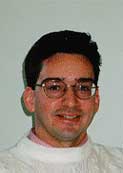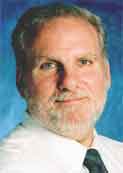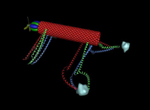Home > Interviews > Dinos Mavroidis - December 2002
Dinos Mavroidis Interview - December 15th, 2002

|
Nanotech Now editor Rocky Rawstern interviews Dinos Mavroidis |
After reading the report "Protein Based Nano-Machines for Space Applications" [A PDF format report by Dr. Constantinos Mavroidis, Associate Professor Robotics and Mechatronics Laboratory, Department of Mechanical & Aerospace Engineering, Rutgers University, The State University of New Jersey], I became curious about the project and their findings. Accordingly, I emailed Dr. Mavroidis to find out more about the work that he and his team performed during Phase I. See also the Rutgers Bio-Nano Robotics website.
You can find the final and full Phase I report to NASA
here
Here is the interview:
Can you give our readers an overview of the "Protein Based Nano-Machines for Space Applications" project?
The long-term goal of this project is to develop novel biomolecular machine components that can be assembled and form multi-degree of freedom nanodevices that will be able to manipulate objects, inspect and be able to travel in the nanoenvironment. Some proteins, due to their structural characteristics and physicochemical properties constitute potential candidates for this role. The short-term goals of this project are: a) To identify proteins that can be used as motors in nano / micro machines and mechanisms. We are focusing our studies on the mechanical properties of viral proteins to open or close depending on the pH level of environment; b) To develop concepts for bio-nano-sensors using natural sensor proteins called Heat Shock Factor (HSF), along with DNA and optical fibers. Being on such a small scale and with a possibility of self-replication in situ, these sensors would be helpful in the detection of life forms in other planets due to their ability to gauge humidity, temperature and other life-supporting chemicals;
c) To develop dynamic models and simulations to accurately predict the performance of the proposed nano-motors and sensors; d) To perform a series of biomolecular experiments to demonstrate the validity of the proposed concepts of nano-motors and nano-sensors; e) To study the interface of the proposed protein motors and sensors with other biomolecular components such as DNA joints and carbon-nanotube rigid links so that complex, multi-degree of freedom machines and robots are formed.
One of your aims seems to be that of building the basic pieces that will enable constructing nanoscale devices. What are the remaining hurdles that need crossing before a practical and functioning nanoscale mechanism [NM] is built?
There are many difficult problems that need to be solved before we obtain ready to be used nano-mechanisms. One of the more important problems is to find ways to interface (i.e. connect) the various nano-machine elements to each other so that we form multi-element assemblies. Another very important problem is "sensing" in the nano-world. We need to have easy to use and accurate sensors that will be able to give us a "view" of the nano-mechanism and its environment. Sensors are also very important for developing control strategies for the nano-mechanisms. I consider these two problems - "sensing" and "assembly" - as the most important, after we have identified the basic elements that are needed to form a nano-machine.
Where/how do you envision a NM being used soonest, and by what date?
I would like to make a distinction between nano-mechanisms and nano-devices. The first is a subset of the latter. Nano-mechanisms are devices that will create and transfer motion and / or force, in order to perform their task. Nano-devices are any type of machines that will be able to perform any type of function in the nano-environment, even tasks that do not require any motion or force generation. I think that we will be able to develop nano-devices performing useful tasks very soon, within the next decade. I believe that the first useful nano-devices will be nano-sensors. For the nano-mechanisms, we will have to wait a long time, probably over 30 years before we see a functioning device in a real task. Of course before that there will be many prototypes of nano-mechanisms in the laboratory. However, I would like to point out that it is very important to have working nano-devices and nano-mechanisms as soon as possible, if we would like to keep the interest and funding of federal agencies and industry at the same level as it is today. There are many examples in the past that certain technologies were very popular for a few years, but the research community was unable to deliver working prototypes for commercial applications in a relatively short time, and as a result we saw a sudden decline in the sponsors' interest, funding, and support.
Were you able to meet the goals of Phase I, and what did you learn along the way?
Yes, we were able to meet the goals of the Phase I NIAC grant in the sense that we made important progress in all specific aims that we initially set. Of course there is still a lot to be done. Please see our report mentioned in answer 1, where we describe in detail our activities. There are three important things that we learned: a) this is really a very exciting field to work in, and the more progress you make the more exciting it gets; b) this is a very difficult field to work. The concepts and hypotheses maybe are simple and obvious, but the demonstrations are very difficult; c) it is a field that requires the work of multi-disciplinary teams.
Were there any surprises, or paths that lead to dead ends?
No, so far we haven't found any paths that lead to dead ends. On the contrary we have found new paths that lead to new directions.
Why biomolecular machine components?
It is well known that outer space, planetary, military and in-body medical missions and interventions will benefit tremendously by decreasing considerably size, weight and cost of hardware and payloads. The development of biomolecular nano-components and devices may be the technological solution in this problem. These devices will be lightweight and hence easy and cost-efficient to be launched or introduced into remote or difficult to reach worlds. They will be designed to be self-replicating, a property that will help create computing stations and manufacturing sites on remote and inaccessible environment and in turn, develop a whole nano-scale industry. One way to fabricate such devices is by using the design and machinery from nature's biomolecular world. ATPase rotary motors, or our proposed concept of VPL motors, are good examples of biomolecular components. The advantage of nature's machine components is that they are highly efficient, well optimized, and as it is obvious they have been tested and their performance is excellent. Moreover, there is a provision of recycling and uninterrupted production, depending upon the need. Since these machines will not actually be living organisms, they will be able to work in the unfavorable environments offered by remote worlds. They will also be able to grow, care for, and protect various forms of life transplanted from Earth to other planets. Figure 1 shows one such concept of a nano-organism, with its 'feet' made of helical peptides, and its body using carbon nanotubes, while the power unit is a biomolecular motor. Figure 2 shows an example of a biomolecular nanorobot repairing an infected cell in a blood vessel. Our goal is that just as conventional macro-machines are used to develop forces and motions to accomplish specific tasks, bio-nano-machines can be used to manipulate nano-objects, to assemble and fabricate other machines or products, and to perform maintenance, repair and inspection operations.
How does this project differ from past or current molecular machine construction attempts?
This project is novel for many reasons. First of all we are proposing and studying a new biomolecular motor that is based on viral proteins. This motor is very powerful, and gives us the possibility to obtain many different motor types, each type having different performance characteristics such as different speeds, displacements or forces. Therefore, for different machines, we will be able to select the optimal motor to perform the task. In addition, we are probably the only team so far that is studying and experimenting with the interface of different machine elements such as joints, structural elements, and motors, so that complex multi-link nano-mechanisms are obtained.
What, if any, are your concerns regarding self replication, sustainability, swarm intelligence and controllability? What ideas are being discussed, and are there any procedures in place to insure safety?
I am not so concerned at this moment with the issues that you are raising. First of all, we are far away from the moment that any one of these issues will be close to becoming a reality. Most of them are closer to the science fiction side, rather then real science. A second reason is that these issues are the same as those that the robotics community has dealt with for a very long time. Therefore, these issues are not new, and there is a huge bank of existing literature on the subject, regarding how the robotics and engineering community could deal with them. Finally, as it is obvious, with every machine there are dangers. The designer and manufacturer of nano-machines will make sure that their operation is safe in every possible way.
What is your relationship with NIAC, and will there be other projects or follow-up to this one?
NIAC is the NASA Institute for Advanced Studies. NIAC was our sponsor for a 6-month Phase I grant to study bio-nano-machines for space applications. NIAC is a special sponsor in the sense that they want to fund very revolutionary projects that can find commercial and space applications, not in the next 5 or 10 years, but in the next 50 years. So they want to fund very revolutionary and high risk projects. Their support was very important to be able to continue our research. We have just submitted a Phase II proposal, requesting additional funding from NIAC for 2 years to be able to continue our work. I have to say at this point that this project is also partially funded by a Small Grant for Exploratory Research (SGER) from the Nano-Manufacturing program of the National Science Foundation (NSF).
Please describe CHARMM, and how your team used it on this project.
CHARMM (Chemistry at HARvard Molecular Mechanics) is a program for macromolecular simulations, including energy minimization, molecular dynamics and Monte Carlo simulations. It was developed by Prof. Karplus' group at Harvard University. In our project it is used to demonstrate in simulation the concept of our proposed Viral Protein Linear (VPL) motor.
Who are the team members, and what is their contribution?
A multidisciplinary team from Rutgers University, The State University of New Jersey, The University of Connecticut and Lucent Technologies' Bell Laboratories has been assembled to study the development of protein-based nano-motors and nano-robots. Our team in composed of experts in many different disciplines and fields that include: a) Robotics, Design and Mechanical Engineering; b) Chemical and Biochemical Engineering; c) Biomedical Engineering; d) Chemistry and Materials Science; e) Physics and Molecular Dynamics.
I would like to give some historical background on the beginning of our project. The initial founders of the project are myself and Prof. Martin Yarmush, who is the chair of the Biomedical Engineering Department at Rutgers University. A turning point was when Prof. Yarmush joined Rutgers in 2000. In a completely unscheduled discussion that year we brainstormed on the possibility of merging robotics and molecular biology. A grant from Rutgers University and the State of New Jersey in 2001-2002, gave us the possibility of starting the project. The first student of the project was Atul Dubey, a graduate student in the department of Mechanical and Aerospace Engineering. He joined the team in June 2001. He was extremely fascinated by this project, and many of the initial ideas and breakthroughs came from him. Very soon the team expanded to the current levels, and definitely will expand more in the coming months.
The following Table summarizes the responsibilities and level of involvement of the team's principal investigators and researchers:
|
Researchers / Role |
Title / Institution |
Research Supervision |
|
Constantinos Mavroidis, Ph.D. |
Associate Professor of Mechanical Engineering at Rutgers University |
Design, Modeling and Simulations of Protein Based Nano-machines |
|
Martin Yarmush, M.D., Ph.D., |
Professor and Chair of Biomedical Engineering at Rutgers University |
Biochemical and Biomedical Components of the Project |
|
Silvina Tomassone, Ph.D. |
Assistant Professor of Chemical and Biochemical Engineering at Rutgers University |
Computational Molecular Dynamics |
|
F. Papadimitrakopoulos, Ph.D., Co-Principal Investigator |
Associate Professor of Chemistry and Associate Director of the Institute of Material Science at the University of Connecticut |
Carbon-Nanotubes and their Interface With VPL Motors and DNA |
|
Bernard Yurke, Ph.D. |
Senior Research Scientist, Lucent Technologies, Bell Labs |
DNA Joints and their Interface With Carbon-Nanotubes |
|
Atul Dubey |
Graduate Student, Department of Mechanical and Aerospace Engineering, Rutgers University |
Modeling and Design of VPL Motors |
|
Kevin Nikitczuk |
Undergraduate Student, Department of Biomedical Engineering, Rutgers University |
Design and Experimental Demonstration of HSF Bio-Sensors |
|
Angela Thornton |
Graduate Student, Department of Biomedical Engineering, Rutgers University |
Biomolecular Experiments with VPL Motors |

|
Dr. Constantinos Mavroidis is a world-renowned expert of design, modeling and computational analysis of robotic and mechanical systems. Dr. Mavroidis is an Associate Professor of Mechanical and Aerospace Engineering at Rutgers University, The State University of New Jersey since July 2001. He is also Visiting Associate Professor of Surgery at Harvard University Medical School and Shriners Hospital for Children in Boston. He is a member of the graduate program of the Department of Biomedical Engineering at Rutgers University and faculty member of CAIP: The Rutgers Center for Advanced Information Processing. Dr. Mavroidis was an Assistant Professor at the Department of Mechanical and Aerospace Engineering at Rutgers University from 1996 to 2001. He received the Diploma in Mechanical Engineering from the National Technical University of Athens, Greece in 1988 and the M.S. and Ph.D. degrees in Mechanical Engineering / Robotics from the University of Paris VI, France, in 1989 and 1993 respectively. From 1993 to 1996 he was a Post-Doctoral Associate at the Department of Mechanical Engineering at the Massachusetts Institute of Technology. He has been a Visiting Scholar at the Department of Mechanical Engineering at Stanford University, CA (summer 1990) and a Visiting Researcher at the University of Tokyo (spring 1991). He has received numerous prestigious awards including Best Paper Award at the ASME Design Technical Conferences (1994), the ASME Freudenstein/General Motors Young Investigators Award (1998), the Johnson and Johnson Discovery Award and the National Science Foundation Early Career Award (2000). He has authored and co-authored more than 100 journal and conference papers and book contributions. He is a Technical Editor of the IEEE/ASME Transactions on Mechatronics and Associate Editor of the ASME Journal of Mechanical Design, Past Chair of the IEEE Central Jersey/Princeton Chapter of the Robotics and Automation Society, Chair of the Robotics Technical Panel of the ASME Dynamics Systems and Control Division and Chair of the Permanent Commission on Communications of IFToMM. |

|
Dr. Martin Yarmush is an internationally recognized biomedical engineer with expertise in biophysical chemistry, tissue engineering and metabolic engineering. Dr. Yarmush is Professor and Chair, of the Biomedical Engineering Department at Rutgers University since 2001. He is also the Director of the Center for Engineering in Medicine, at the Massachusetts General Hospital and Shriners Hospital for Children in Boston (since 1995). From 1988 to 1995 he was Professor and Deputy Chair, Department of Chemical and Biochemical Engineering and the Center for Advanced Biotechnology and Medicine, Rutgers University. He has received numerous prestigious awards including National Research Service Award, National Cancer Institute, 1985 Lucille P. Markey Scholar Award in Biomedical Science, 1988 NSF Presidential Young Investigator Award, 1989 NIH Research Career Development Award, 1992 Board of Trustees Award for Excellence in Research; 1993 Founding Fellow - American Institute of Medical and Biological Engineering; 1994 Hoechst Celanese Innovative Research; 1996 "Martin L. Yarmush Student Award in Biotechnology", Student Award Established, Rutgers U.; 1996 Bernard Revel Memorial Award in Arts & Sciences, Yeshiva University; 1998 AIChE Bioengineering Division Plenary Speaker; 1999 Institution for Medicine and Engineering, Distinguished Lecturer, University of Pennsylvania; 1999 Department of Chemical Engineering, Miller Lecturer, Iowa State University; 2001 Department of Chemical Engineering, Merck Distinguished Lecturer, Rutgers University. He has authored and co-authored over 220 journal papers. |
If you have a comment, please
us.
|
|
||
|
|
||
| The latest news from around the world, FREE | ||
|
|
||
|
|
||
| Premium Products | ||
|
|
||
|
Only the news you want to read!
Learn More |
||
|
|
||
|
Full-service, expert consulting
Learn More |
||
|
|
||

